Investigating the Role of Extreme Synoptic Patterns and Complex Topography During Two Heavy Rainfall Events in Crete in February 2019
Abstract
1. Introduction
2. Study Area, Data, and Methodology
2.1. Study Area
2.2. Data Sources
2.3. Methodology
3. Results
3.1. Rainfall Distribution of the Two Storms
3.2. Synoptic-Scale Setting of the Two Storms
3.2.1. Chioni Storm
- A “river” of high EPWAT spanning over the Aegean Sea towards Crete.
- High values of 10-m wind speed, up to 18 m s−1 offshore the northern coasts of Crete. These values are in close agreement with surface observations from stations located over the Aegean and west Crete.
- Strong low-level convergence in the windward side of the western White Mountains, reaching 2 × 10−4 × s−1.
3.2.2. Oceanis Storm
3.3. Synoptic-Scale Rank of the Two Storms
3.4. Satellite Imagery and Convective Activity During the Two Storms
3.5. Soil Moisture
4. Discussion—Concluding Remarks
- Synoptic setting: During both storms, the synoptic setup was similar, with a relatively deep low-pressure system in the vicinity of Crete and a high-pressure system over western Europe. Concerning the departure from the normal means, the meteorological situation in western Europe during Oceanis was reported as a record-breaking event, at least as far as the unseasonably high temperatures in northwest Europe are concerned.
- Advection of moist air and persistence of impinging flow: During both storms, a strong flow towards the White Mountains for a long period of time led to a continuous inflow of low-level humid air towards the mountain barriers. In addition, long-lasting low-level convergence zones considerably promoted convection over the western parts of the island (see Figure 6 and Figure 9). The magnitude of the low-level convergence was higher and more persistent during the second storm.
- Degree of blocking of the impinging flow: Thorough inspection of satellite imagery revealed that during the first phase of Chioni, embedded convective cells developed over western Crete. During the second phase of Chioni, the clouds and rainfall regime were almost purely stratiform. This is an indication of a flow that gradually evolves from neutral/slightly unstable conditions to stable conditions and therefore from unblocked to a more blocked flow. This feature is also supported by the day-to-day lightning activity over the island, as well as from the rainfall spikes evident in the surface observations depicted in Figure 12. During the second storm Oceanis, the flow was unblocked for a longer period of time, leading to a more convective nature of the rainfall regime, as also shown in the time evolution of cloud tops’ brightness temperature and the corresponding rainfall rates at the ground (see Figure 14). This unblocked flow finally generated higher accumulations of rainfall at the ground and at shorter time periods.
- Microphysical transformations within clouds: During the first phase of the Chioni storm, the height of the 0 °C isotherm was at ~1750 m above mean sea level and during the second storm Oceanis at ~1800 m. As pointed out in Rotunno and Houze [34], unblocked flow leads more easily to condensation ahead of a barrier, enhancing riming processes on the cold part of the clouds, which in both cases examined in this work start at ~1800 m (lower than the top of the White Mountains at 2450 m). Riming and production of graupel within the cold cloud layers produces heavier particles that rapidly fall on the windward slopes of the mountains. This feature shortens the time between the generation of new cloud liquid water by the upward unstable flow and the fallout of rainfall at the sloping surface. Coalescence of cloud droplets below the 0 °C isotherm is also an important factor for rainfall generation, but due to the thin layer (~1000–1200 m between the LCL and the 0 °C isotherm), this factor is not the predominant one during the cases analyzed in this work. Although the absence of radar measurements prohibited the microphysical analysis of the clouds in the two storms, a strong indication of the predominance of riming and the production of heavier particles with larger fall velocities was provided from the rapid response (~10–20 min) of the fallout of rainfall and appearance of embedded convective cells depicted in the satellite imagery. This mechanism, as conceptually presented in Rotunno and Houze [34] (see their Figure 15), is a very efficient way for producing high rainfall amounts at short time scales in many mountain ranges in the Mediterranean and elsewhere.
Author Contributions
Funding
Acknowledgments
Conflicts of Interest
Appendix A
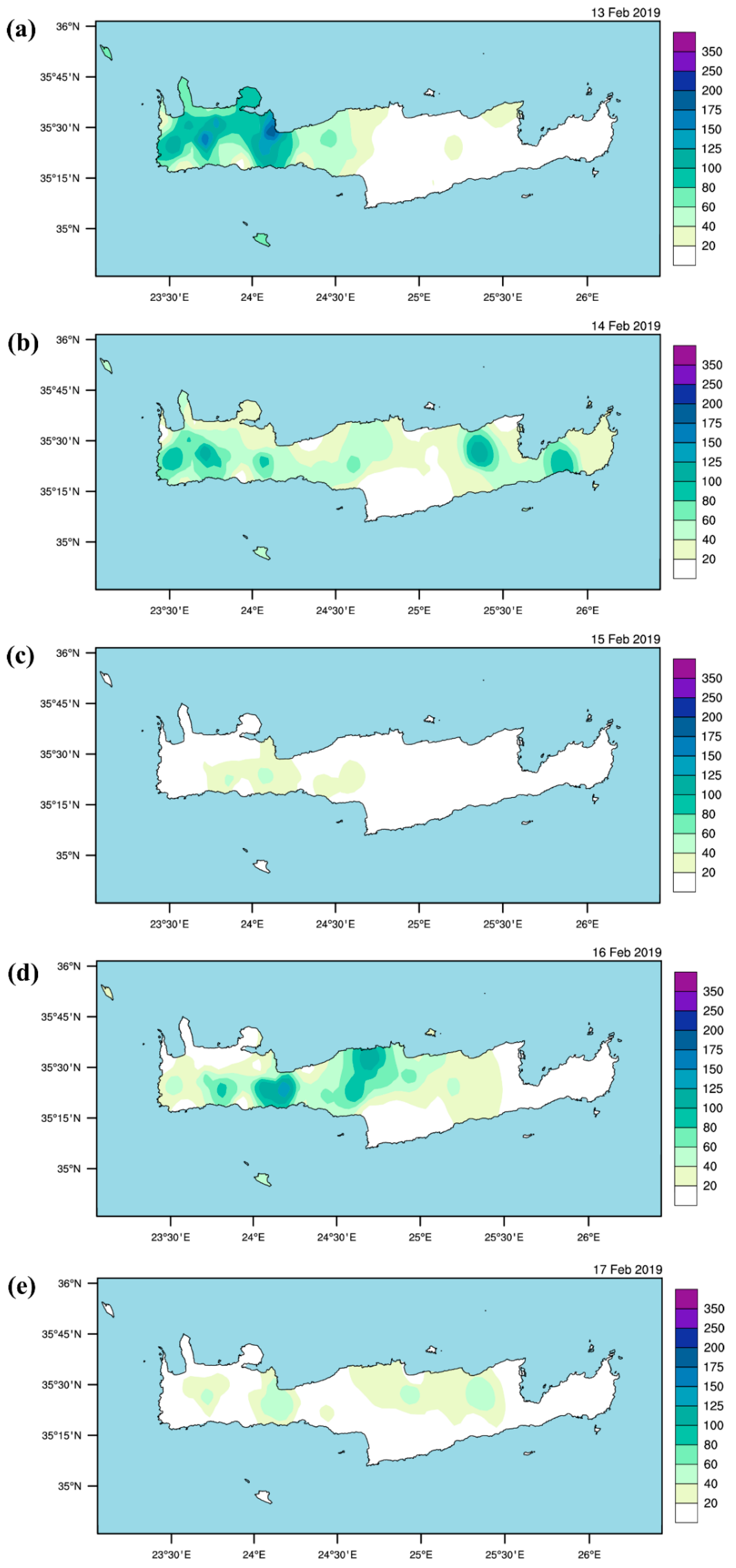
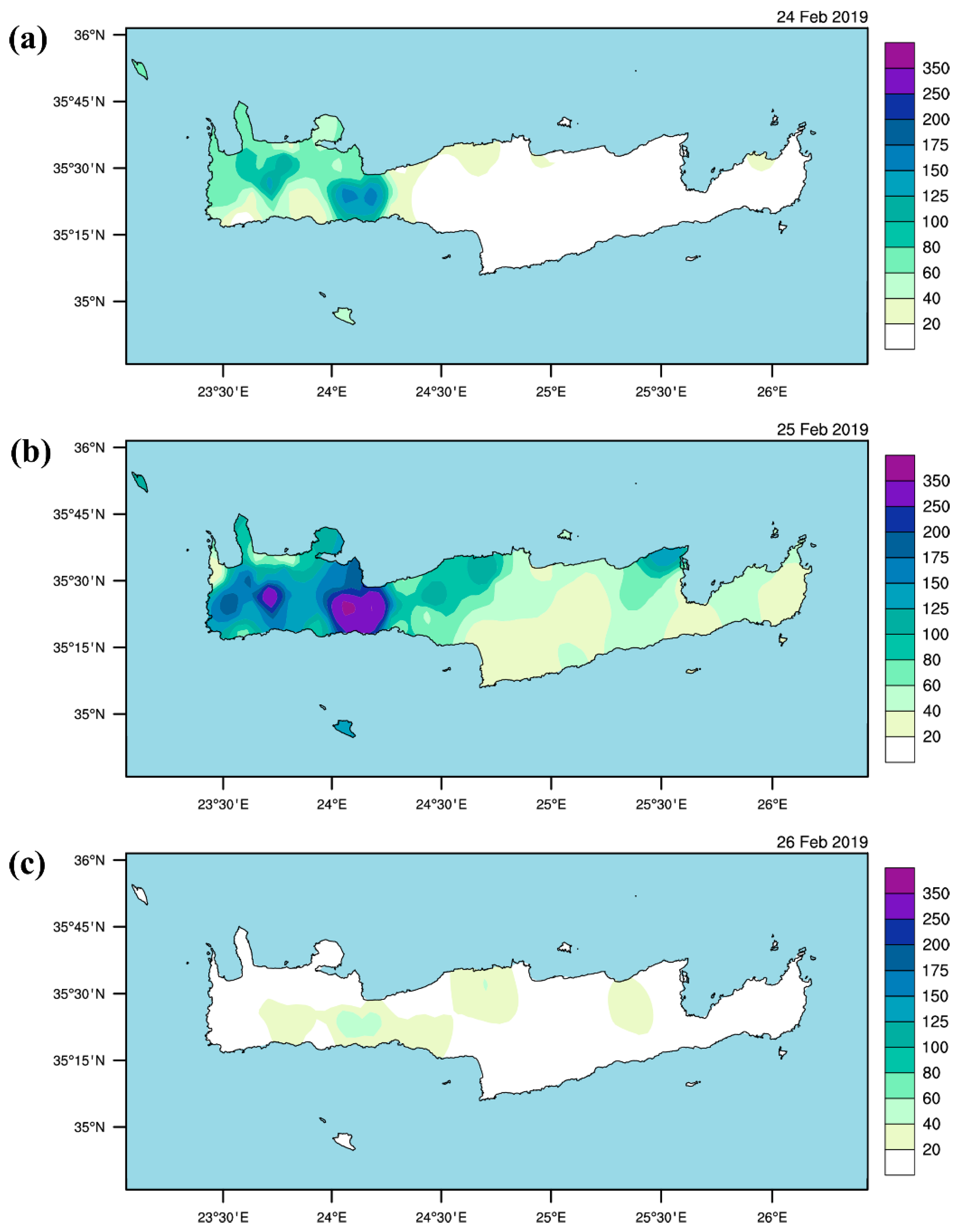
Appendix B
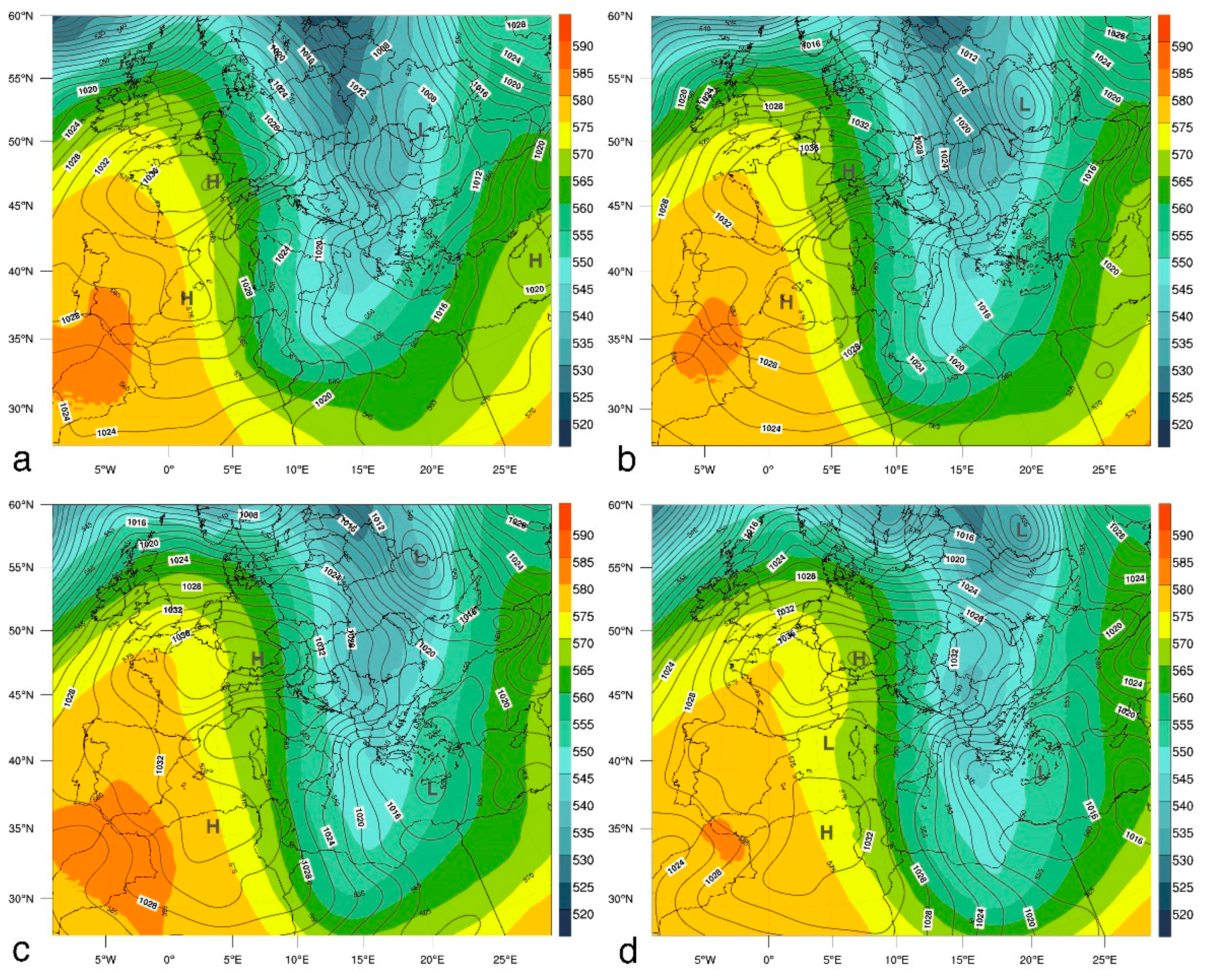
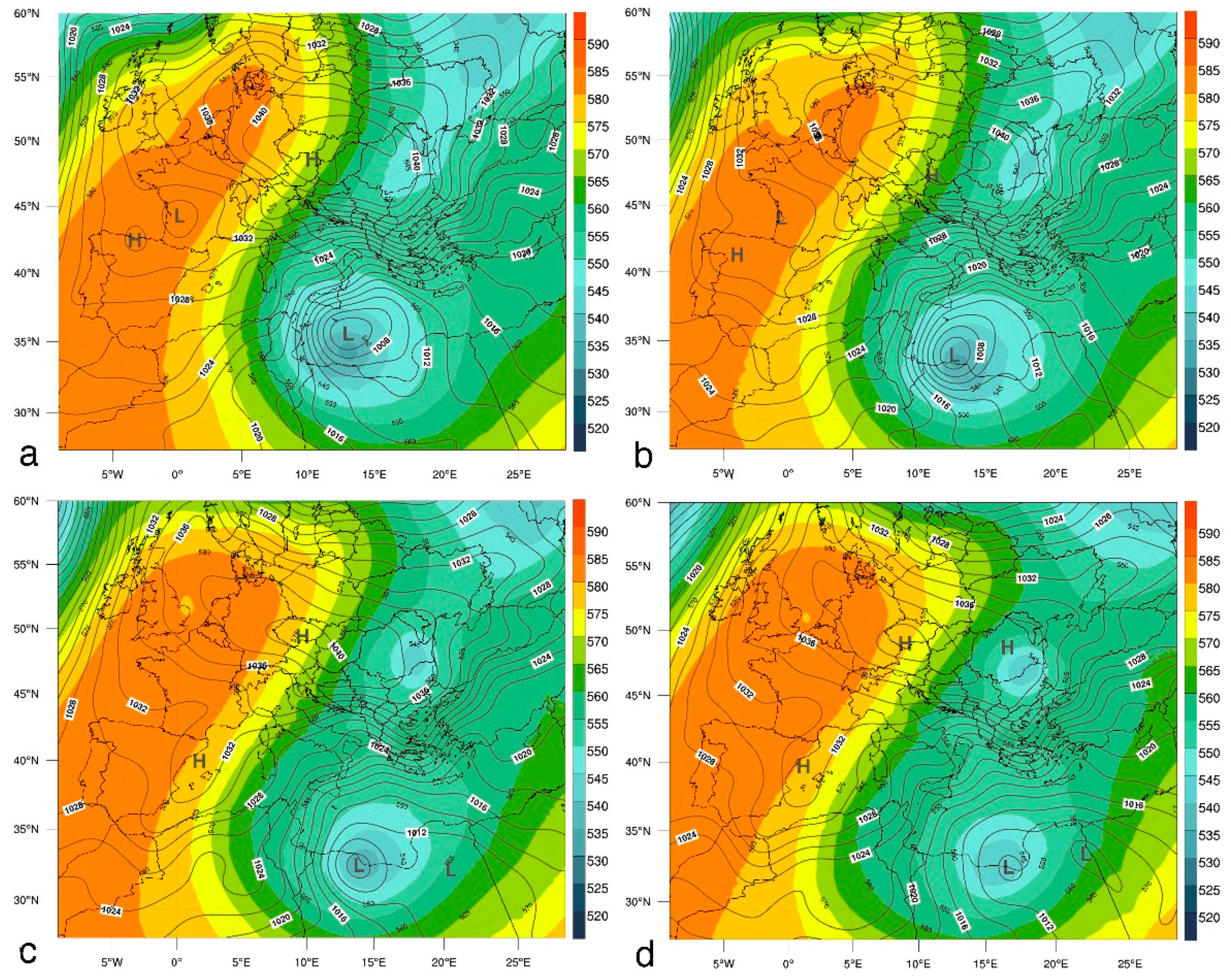
References
- Drobinski, P.; Ducrocq, V.; Alpert, P.; Anagnostou, E.; Béranger, K.; Borga, M.; Braud, I.; Chanzy, A.; Davolio, S.; Delrieu, G.; et al. HyMeX: A 10-Year Multidisciplinary Program on the Mediterranean Water Cycle. Bull. Am. Meteorol. Soc. 2013, 95, 1063–1082. [Google Scholar] [CrossRef]
- Scheffknecht, P.; Richard, E.; Lambert, D. Climatology of Heavy Precipitation over Corsica in the Period 1985–2015. Q. J. R. Meteorol. Soc. 2017, 143, 2987–2998. [Google Scholar] [CrossRef]
- Ehmele, F.; Barthlott, C.; Corsmeier, U. The influence of Sardinia on Corsican rainfall in the western Mediterranean Sea: A numerical sensitivity study. Atmos. Res. 2015, 153, 451–464. [Google Scholar] [CrossRef]
- Metzger, J.; Barthlott, C.; Kalthoff, N. Impact of upstream flow conditions on the initiation of moist convection over the island of Corsica. Atmos. Res. 2014, 145–146, 279–296. [Google Scholar] [CrossRef]
- Adler, B.; Kalthoff, N.; Kohler, M.; Handwerker, J.; Wieser, A.; Corsmeier, U.; Kottmeier, C.; Lambert, D.; Bock, O. The variability of water vapour and pre-convective conditions over the mountainous island of Corsica. Q. J. R. Meteorol. Soc. 2016, 142, 335–346. [Google Scholar] [CrossRef]
- Lambert, D.; Mallet, M.; Ducrocq, V.; Dulac, F.; Gheusi, F.; Kalthoff, N. CORSiCA: A Mediterranean atmospheric and oceanographic observatory in Corsica within the framework of HyMeX and ChArMEx. Adv. Geosci. 2011, 26, 125–131. [Google Scholar] [CrossRef][Green Version]
- Coquillat, S.; Defer, E.; de Guibert, P.; Lambert, D.; Pinty, J.-P.; Pont, V.; Prieur, S.; Thomas, R.J.; Krehbiel, P.R.; Rison, W. SAETTA: High-resolution 3-D mapping of the total lightning activity in the Mediterranean Basin over Corsica, with a focus on a mesoscale convective system event. Atmos. Meas. Tech. 2019, 12, 5765–5790. [Google Scholar] [CrossRef]
- Erdmann, F.; Defer, E.; Caumont, O.; Blakeslee, R.J.; Pédeboy, S.; Coquillat, S. Concurrent Satellite and ground-based Lightning Observations from the Optical Lightning Imaging Sensor (ISS-LIS), the LF network Meteorage and the SAETTA LMA in the northwestern Mediterranean region. Atmos. Meas. Tech. 2020, 13, 853–875. [Google Scholar] [CrossRef]
- Ramis, C.; Homar, V.; Amengual, A.; Romero, R.; Alonso, S. Daily precipitation records over mainland Spain and the Balearic Islands. Nat. Hazards Earth Syst. Sci. 2013, 13, 2483–2491. [Google Scholar] [CrossRef]
- Mayol, T.L.; Homar, V.; Ramis, C.; Guijarro, J.-A. PREGRIDBAL 1.0: Towards a high-resolution rainfall atlas for the Balearic Islands (1950–2009). Nat. Hazards Earth Syst. Sci. 2017, 17, 1061–1074. [Google Scholar] [CrossRef]
- Vinet, F.; Bigot, V.; Petrucci, O.; Papagiannaki, K.; Llasat, M.C.; Kotroni, V.; Boissier, L.; Aceto, L.; Grimalt, M.; Llasat-Botija, M.; et al. Mapping flood-related mortality in the Mediterranean basin. Results from the MEFF 2.0 DB. Water 2019, 11, 2196. [Google Scholar] [CrossRef]
- Kotroni, V.; Lagouvardos, K.; Lalas, D. The effect of the island of Crete on the Etesian winds over the Aegean Sea. Q. J. R. Meteorol. Soc. 2001, 127, 1917–1937. [Google Scholar] [CrossRef]
- Tzoraki, O.; Kritsotakis, M.; Baltas, E. Spatial Water Use efficiency Index towards resource sustainability: Application in the island of Crete, Greece. Int. J. Water Resour. Dev. 2015, 31, 669–681. [Google Scholar] [CrossRef]
- Lagouvardos, K.; Kotroni, V.; Bezes, A.; Koletsis, I.; Kopania, T.; Lykoudis, S.; Mazarakis, N.; Papagiannaki, K.; Vougioukas, S. The automatic weather stations NOANN network of the National Observatory of Athens: Operation and database. Geosci. Data J. 2017, 4, 4–16. [Google Scholar] [CrossRef]
- Koutroulis, A.G.; Tsanis, I.K.; Daliakopoulos, I.N. Seasonality of floods and their hydrometeorologic characteristics in the island of Crete. J. Hydrol. 2010, 394, 90–100. [Google Scholar] [CrossRef]
- Kotroni, V.; Lagouvardos, K. Lightning in the Mediterranean and its relation with sea-surface temperature. Environ. Res. Lett. 2016, 11, 34006. [Google Scholar] [CrossRef]
- Galanaki, E.; Kotroni, V.; Lagouvardos, K.; Argiriou, A. A ten-year analysis of cloud-to-ground lightning activity over the Eastern Mediterranean region. Atmos. Res. 2015, 166, 213–222. [Google Scholar] [CrossRef]
- Kalnay, E.; Kanamitsu, M.; Kistler, R.; Collins, W.; Deaven, D.; Gandin, L.; Iredell, M.; Saha, S.; White, G.; Woollen, J.; et al. The NCEP/NCAR 40-Year Reanalysis Project. Bull. Amer. Meteor. Soc. 1996, 77, 437–472. [Google Scholar] [CrossRef]
- Reichle, R.; De Lannoy, G.; Koster, R.D.; Crow, W.T.; Kimball, J.S.; Liu, Q. SMAP L4 Global 3-Hourly 9 km EASE-Grid Surface and Root Zone Soil Moisture Analysis Update; Version 4. [SPL4SMAU]; NASA National Snow and Ice Data Center Distributed Active Archive Center: Boulder, CO, USA, 2018. [Google Scholar] [CrossRef]
- Reichle, R.H.; Liu, Q.; Koster, R.D.; Crow, W.T.; De Lannoy, G.J.M.; Kimball, J.S.; Ardizzone, J.V.; Bosch, D.; Colliander, A.; Cosh, M.; et al. Version 4 of the SMAP Level-4 Soil Moisture Algorithm and Data Product. J. Adv. Model. Earth Syst. 2019, 11, 3106–3130. [Google Scholar] [CrossRef]
- Khodayar, S.; Kalthoff, N.; Kottmeier, C. Atmospheric conditions associated with heavy precipitation events in comparison to seasonal means in the western Mediterranean region. Clim. Dyn. 2018, 51, 951–967. [Google Scholar] [CrossRef]
- Kirshbaum, J.D.; Adler, B.; Kalthoff, N.; Barthlott, C.; Serafin, S. Moist Orographic Convection: Physical Mechanisms and Links to Surface-Exchange Processes. Atmosphere 2018, 9, 80. [Google Scholar] [CrossRef]
- Weller, E.; Jakob, C.; Reeder, M.J. Projected Response of Low-Level Convergence and Associated Precipitation to Greenhouse Warming. Geophys. Res. Lett. 2017, 44, 10610–682690. [Google Scholar] [CrossRef]
- Houze, R.A., Jr. Orographic effects on precipitating clouds. Rev. Geophys. 2012, 50. [Google Scholar] [CrossRef]
- Young, M.; Galvin, J. The record-breaking warm spell of February 2019 in Britain, the Channel Islands, France and the Netherlands. Weather 2020, 75, 36–45. [Google Scholar] [CrossRef]
- Lackmann, G.M.; Gyakum, J.R. Heavy cold-season precipitation in the Northwestern United States: Synoptic climatology and an analysis of the flood of 17–18 January. Weather Forecast. 1999, 14, 687–700. [Google Scholar] [CrossRef]
- Grumm, R.H.; Hart, R. 2001: Standardized anomalies applied to significant cold season weather events. Preliminary findings. Weather Forecast. 2001, 16, 736–754. [Google Scholar] [CrossRef]
- Blaisdell, E.A. Statistics in Practice; Saunders College Publishing: New York, NY, USA, 1993; p. 653. [Google Scholar]
- Feidas, H.; Giannakos, A. Identifying precipitating clouds in Greece using multispectral infrared Meteosat Second Generation satellite data. Theor. Appl. Climatol. 2011, 104, 25–42. [Google Scholar] [CrossRef]
- Senf, F.; Dietzsch, F.; Hünerbein, A.; Deneke, H. Characterization of Initiation and Growth of Selected Severe Convective Storms over Central Europe with MSG-SEVIRI. J. Appl. Meteorol. Climatol. 2014, 54, 207–224. [Google Scholar] [CrossRef]
- Kumar, A.; Houze, R.A.; Rasmussen, K.L.; Peters-Lidard, C. Simulation of a Flash Flooding Storm at the Steep Edge of the Himalayas. J. Hydrometeorol. 2013, 15, 212–228. [Google Scholar] [CrossRef]
- Houze, R.A.; McMurdie, L.A.; Rasmussen, K.L.; Kumar, A.; Chaplin, M.M. Multiscale Aspects of the Storm Producing the June 2013 Flooding in Uttarakhand, India. Mon. Weather Rev. 2017, 145, 4447–4466. [Google Scholar] [CrossRef]
- Medina, S.; Houze, R.A. Air motions and precipitation growth in Alpine storms. Q. J. R. Meteorol. Soc. 2003, 129, 345–371. [Google Scholar] [CrossRef]
- Rotunno, R.; Houze, R.A. Lessons on orographic precipitation from the Mesoscale Alpine Programme. Q. J. R. Meteorol. Soc. 2007, 133, 811–830. [Google Scholar] [CrossRef]

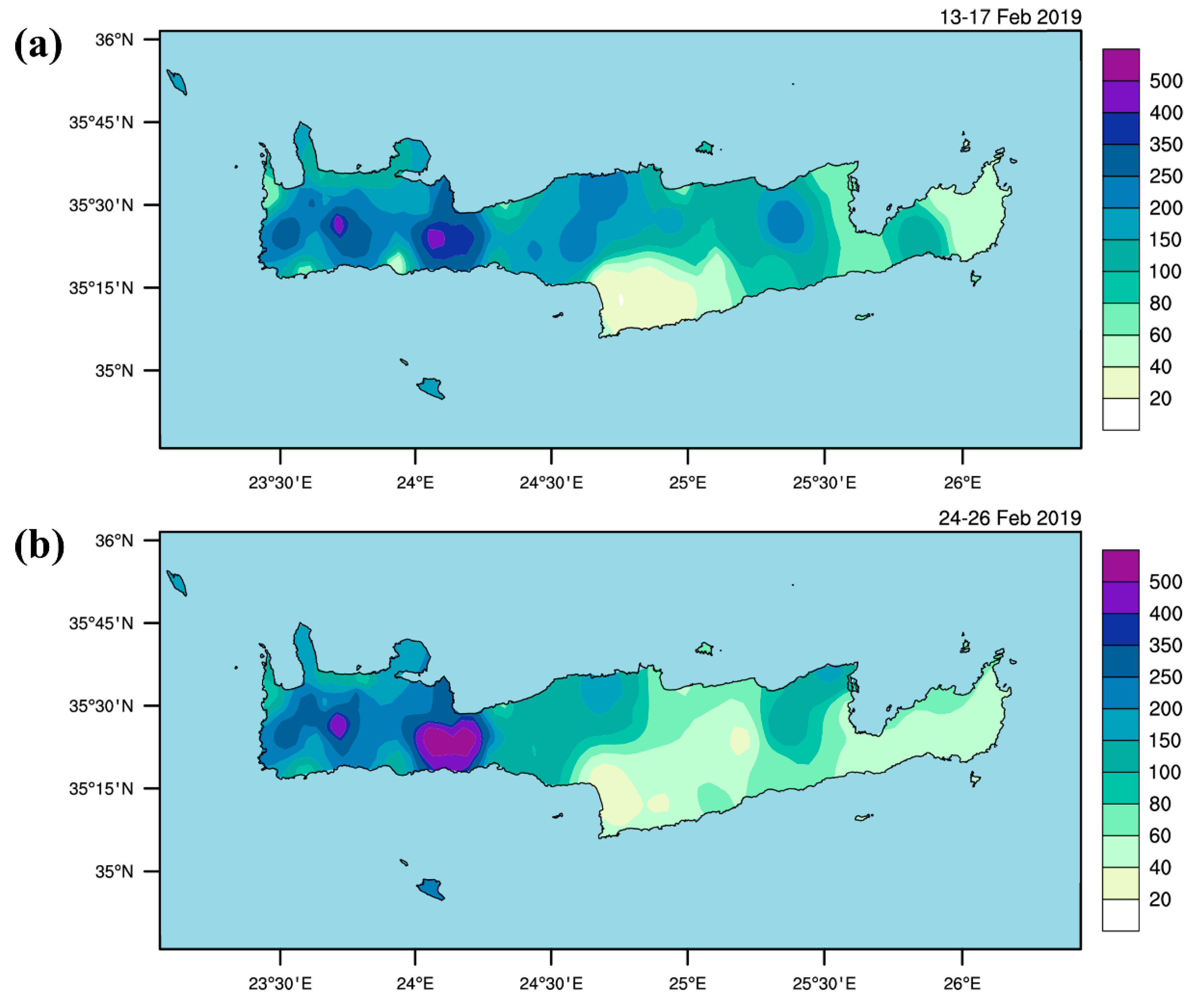
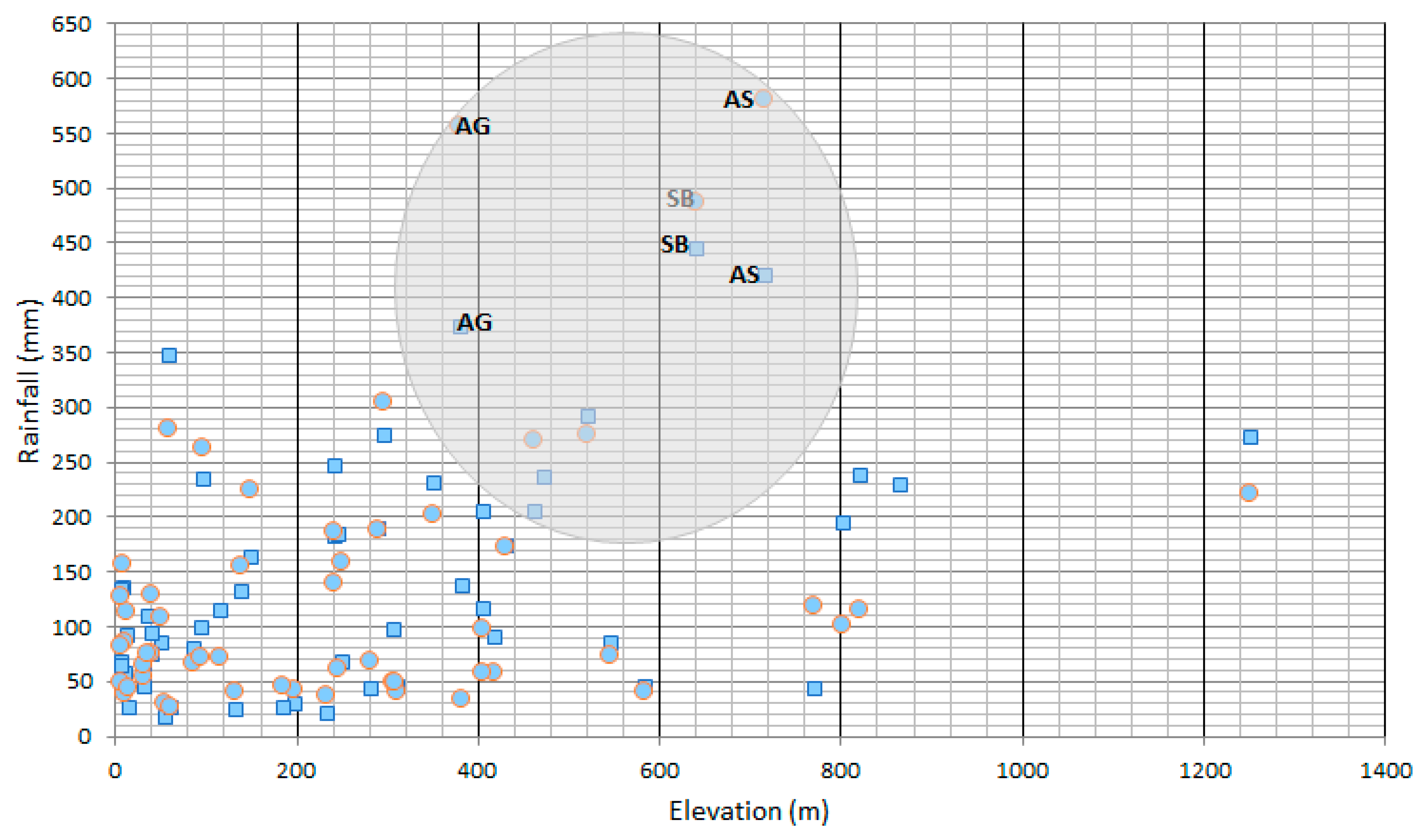
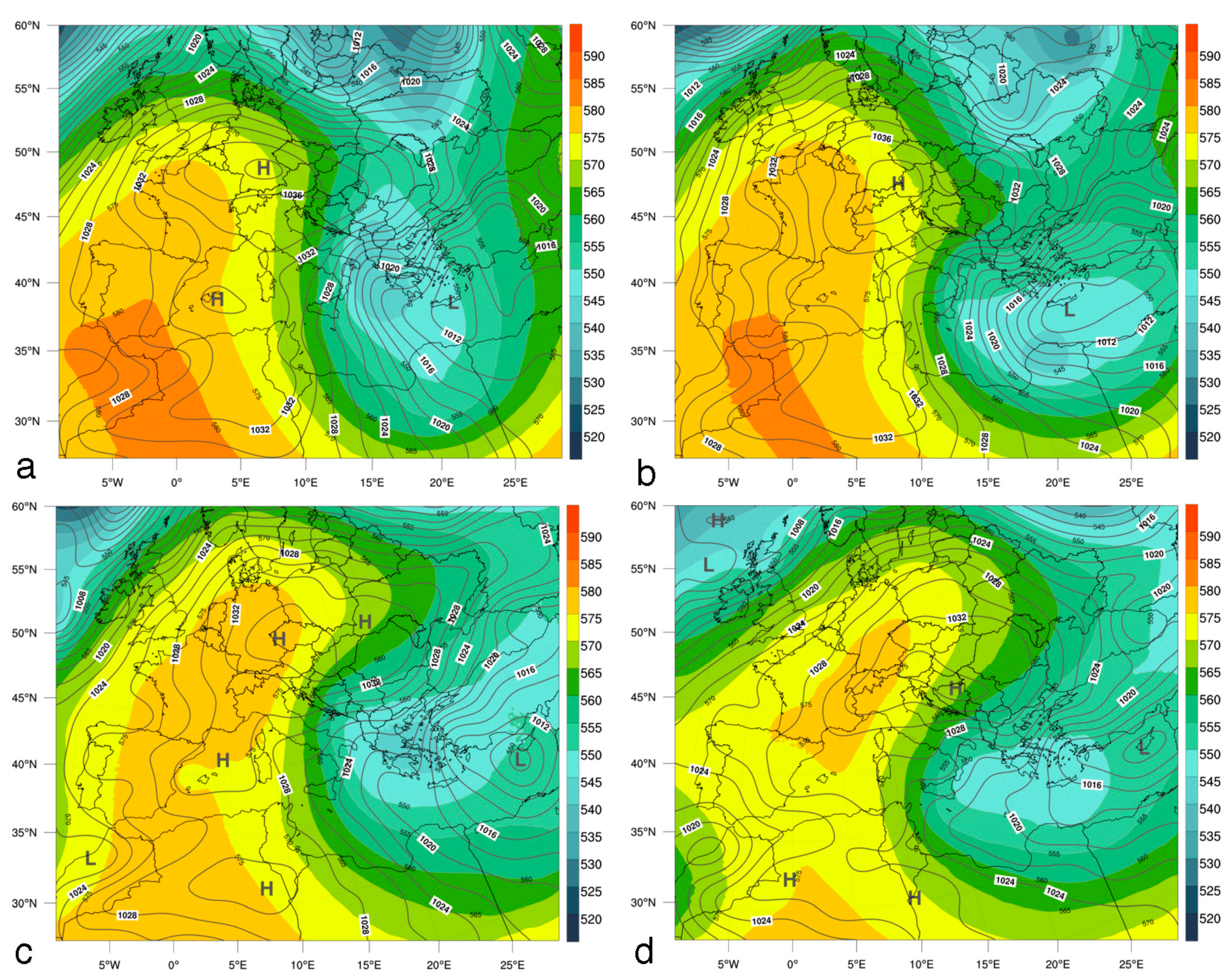
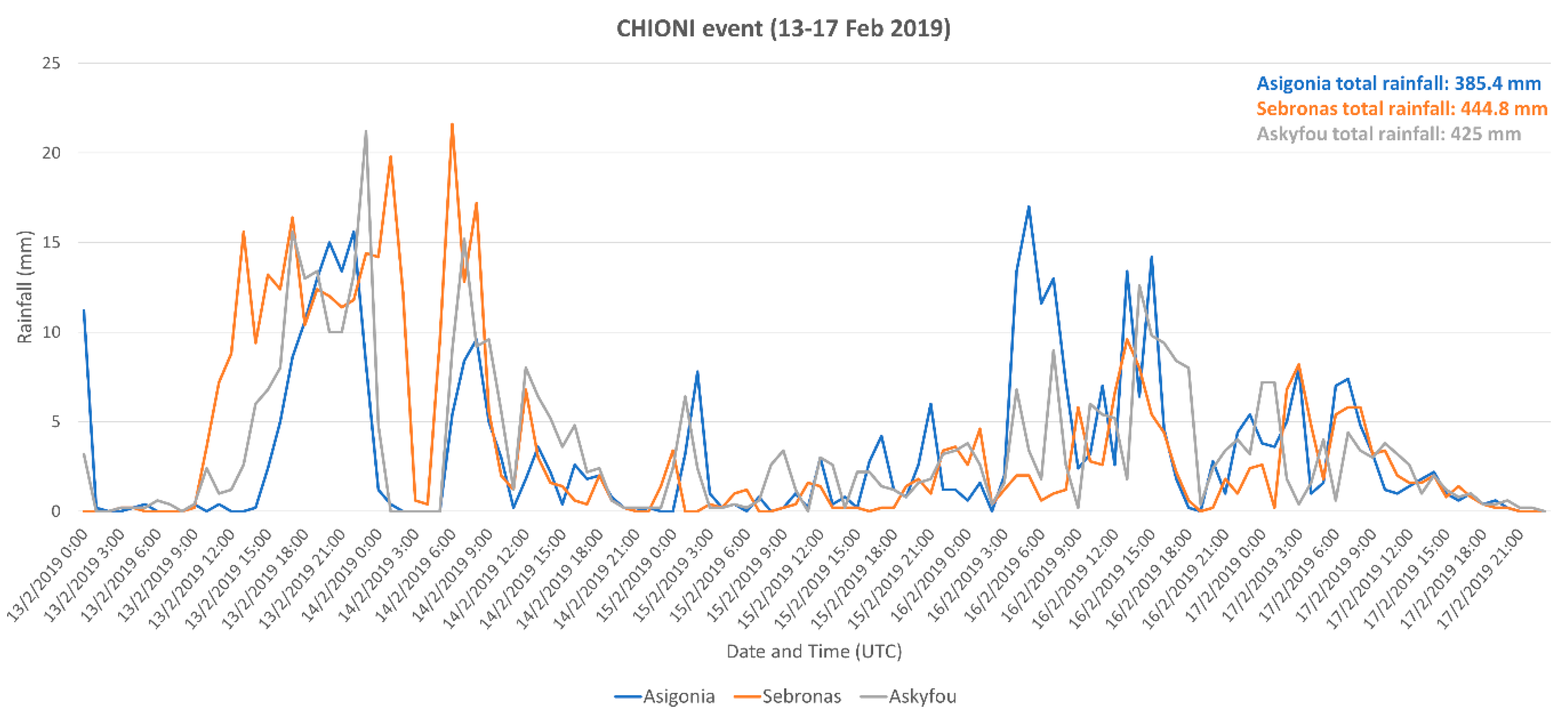
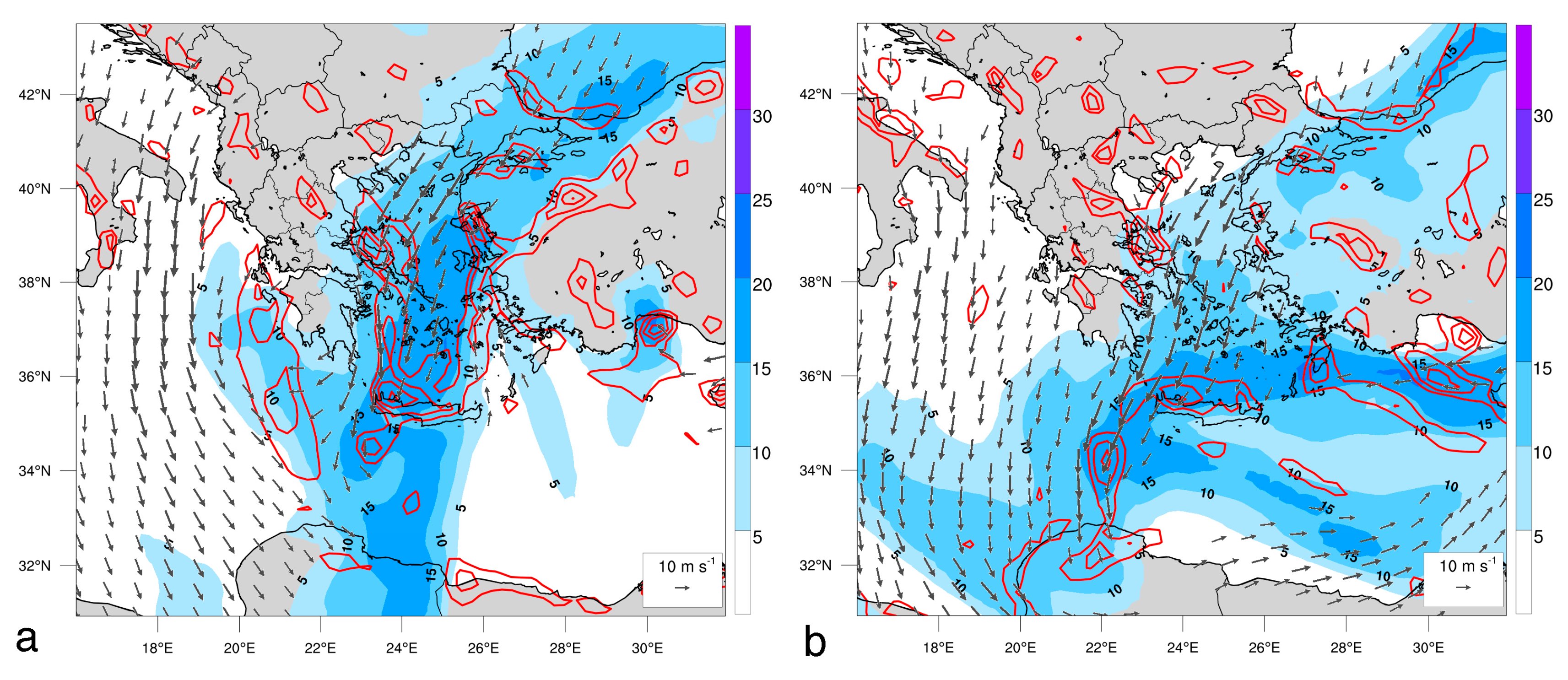
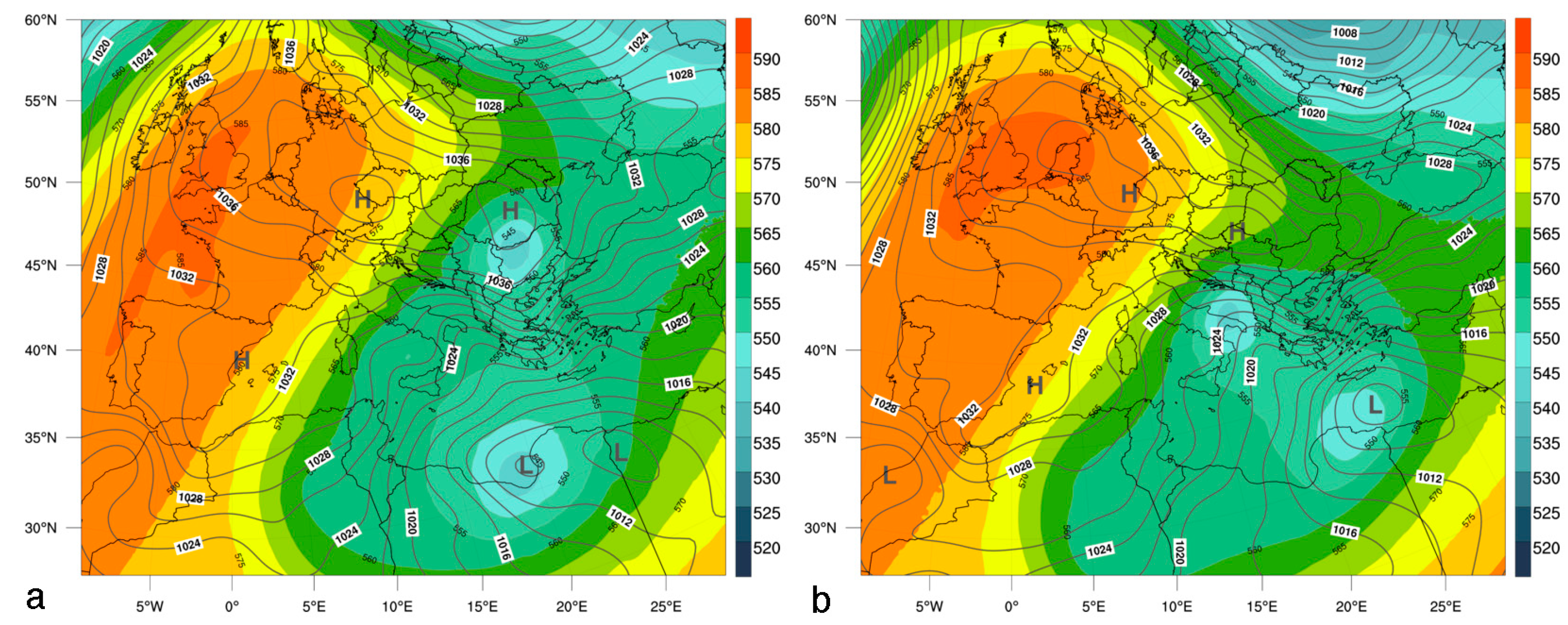
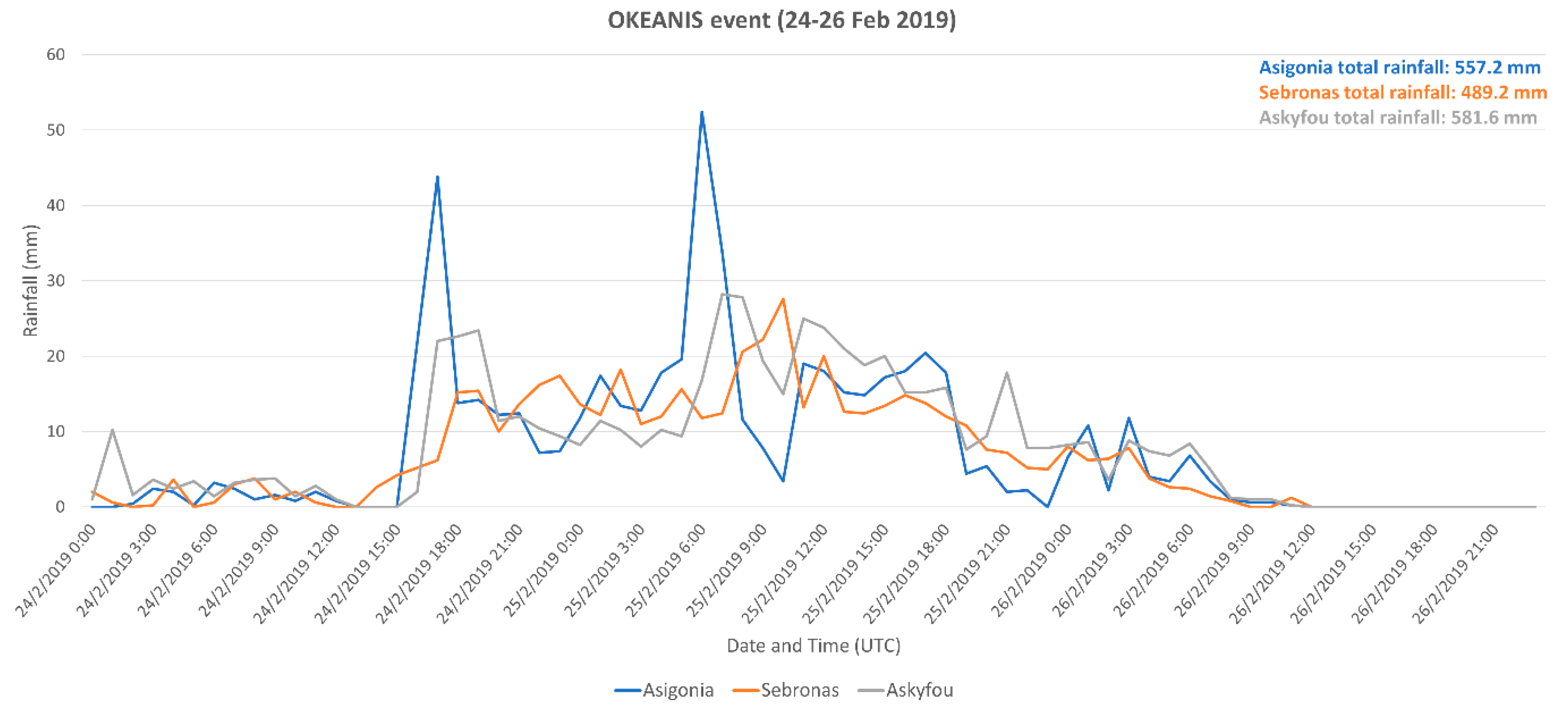
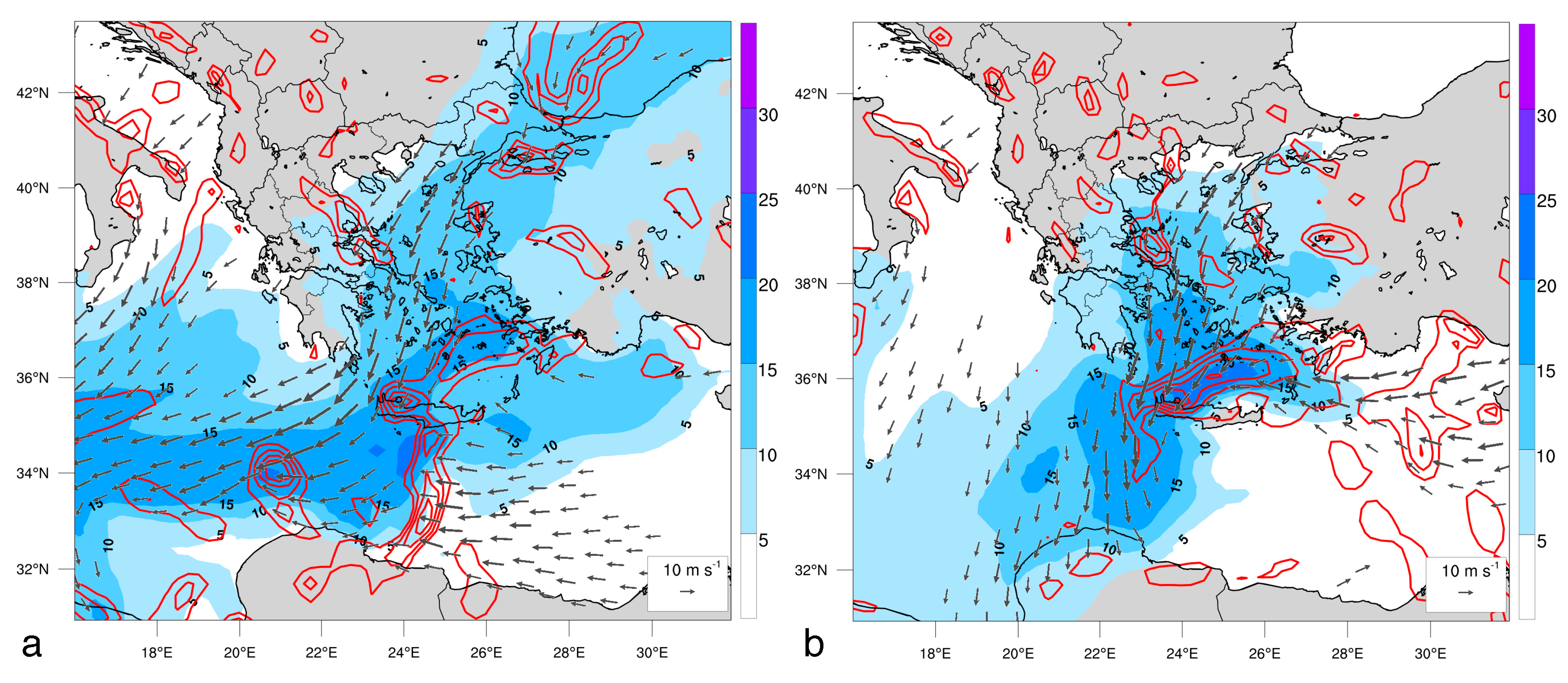
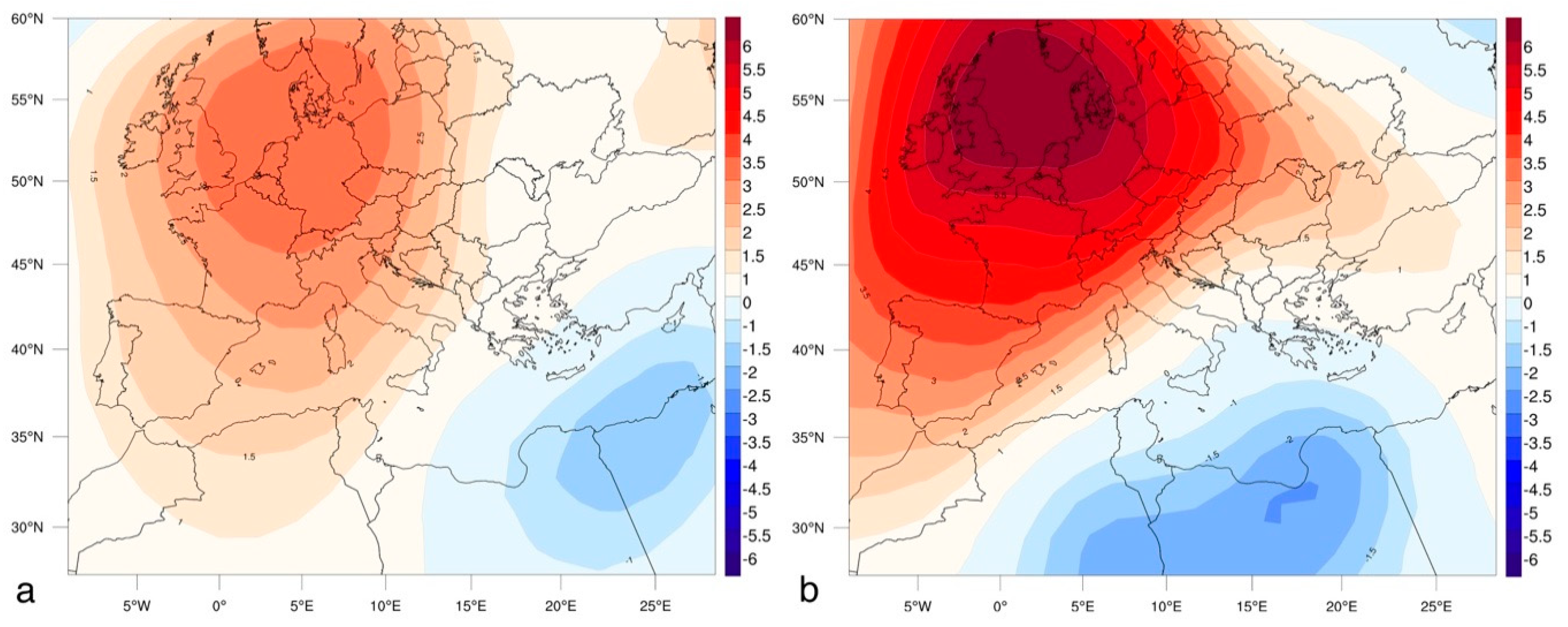
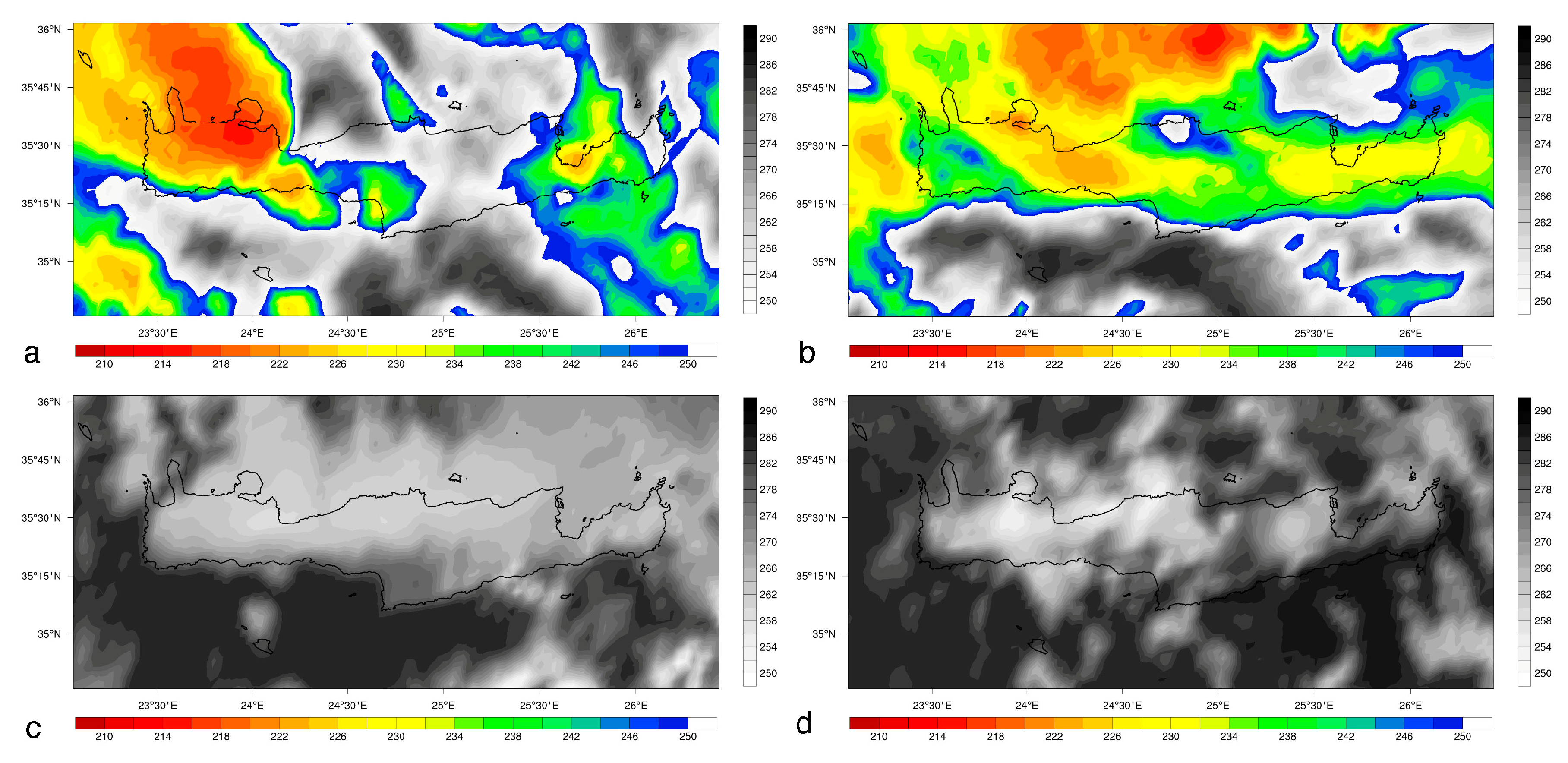
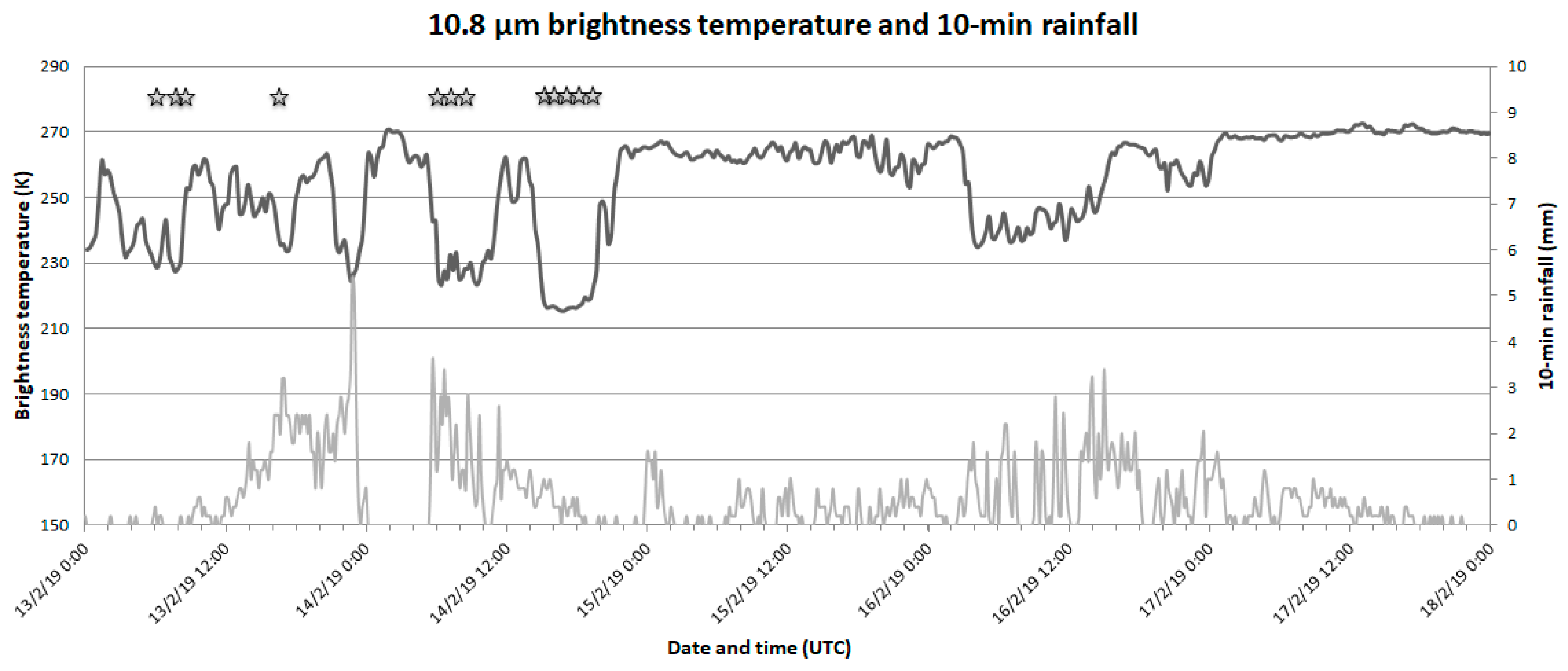

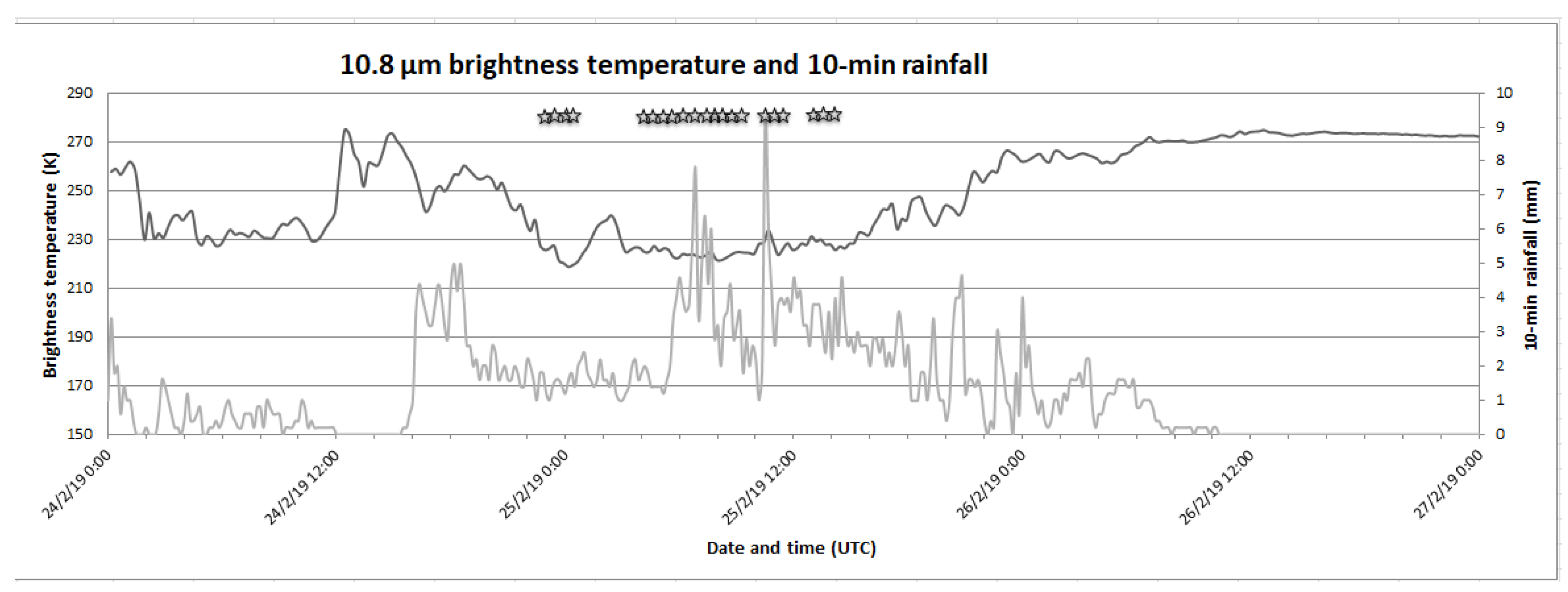
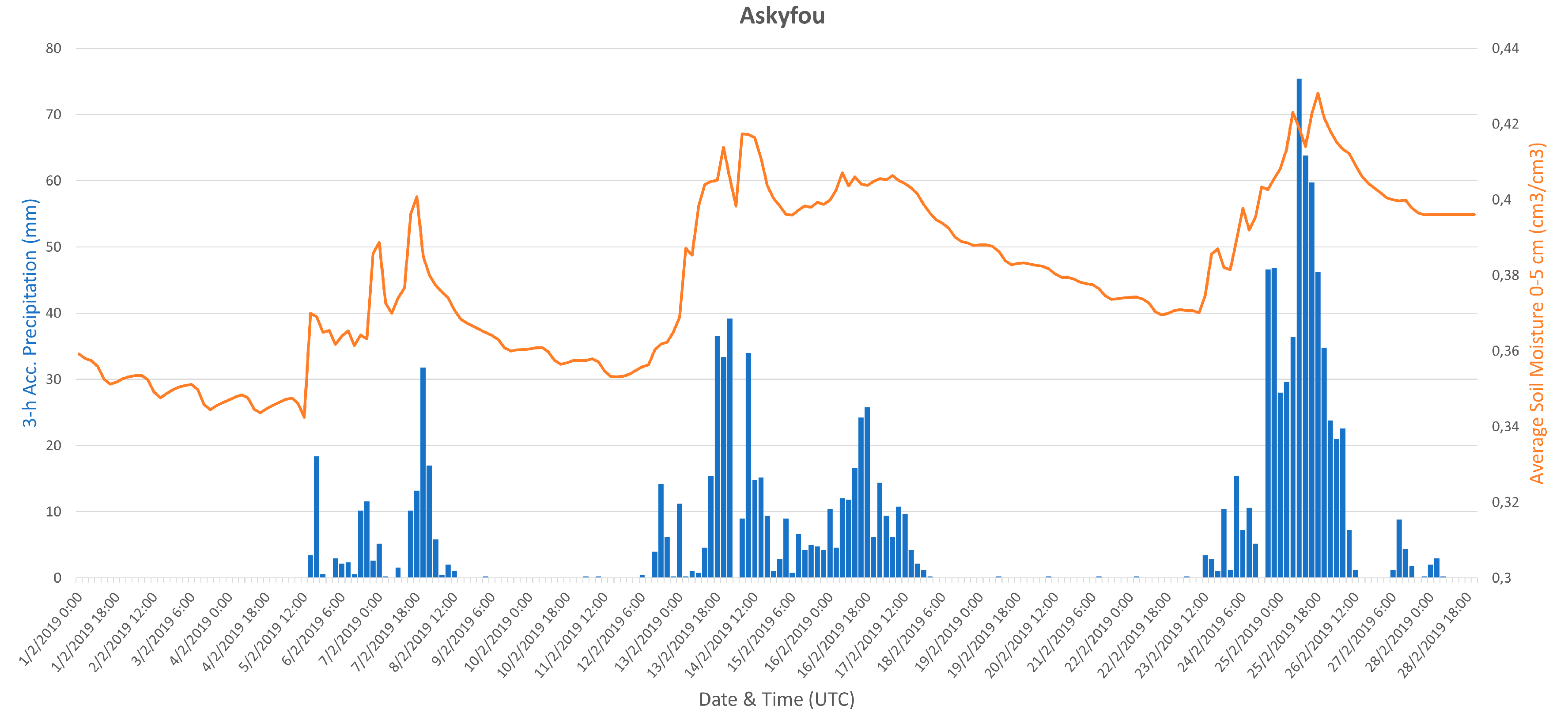
© 2020 by the authors. Licensee MDPI, Basel, Switzerland. This article is an open access article distributed under the terms and conditions of the Creative Commons Attribution (CC BY) license (http://creativecommons.org/licenses/by/4.0/).
Share and Cite
Lagouvardos, K.; Dafis, S.; Giannaros, C.; Karagiannidis, A.; Kotroni, V. Investigating the Role of Extreme Synoptic Patterns and Complex Topography During Two Heavy Rainfall Events in Crete in February 2019. Climate 2020, 8, 87. https://doi.org/10.3390/cli8070087
Lagouvardos K, Dafis S, Giannaros C, Karagiannidis A, Kotroni V. Investigating the Role of Extreme Synoptic Patterns and Complex Topography During Two Heavy Rainfall Events in Crete in February 2019. Climate. 2020; 8(7):87. https://doi.org/10.3390/cli8070087
Chicago/Turabian StyleLagouvardos, Konstantinos, Stavros Dafis, Christos Giannaros, Athanassios Karagiannidis, and Vassiliki Kotroni. 2020. "Investigating the Role of Extreme Synoptic Patterns and Complex Topography During Two Heavy Rainfall Events in Crete in February 2019" Climate 8, no. 7: 87. https://doi.org/10.3390/cli8070087
APA StyleLagouvardos, K., Dafis, S., Giannaros, C., Karagiannidis, A., & Kotroni, V. (2020). Investigating the Role of Extreme Synoptic Patterns and Complex Topography During Two Heavy Rainfall Events in Crete in February 2019. Climate, 8(7), 87. https://doi.org/10.3390/cli8070087








